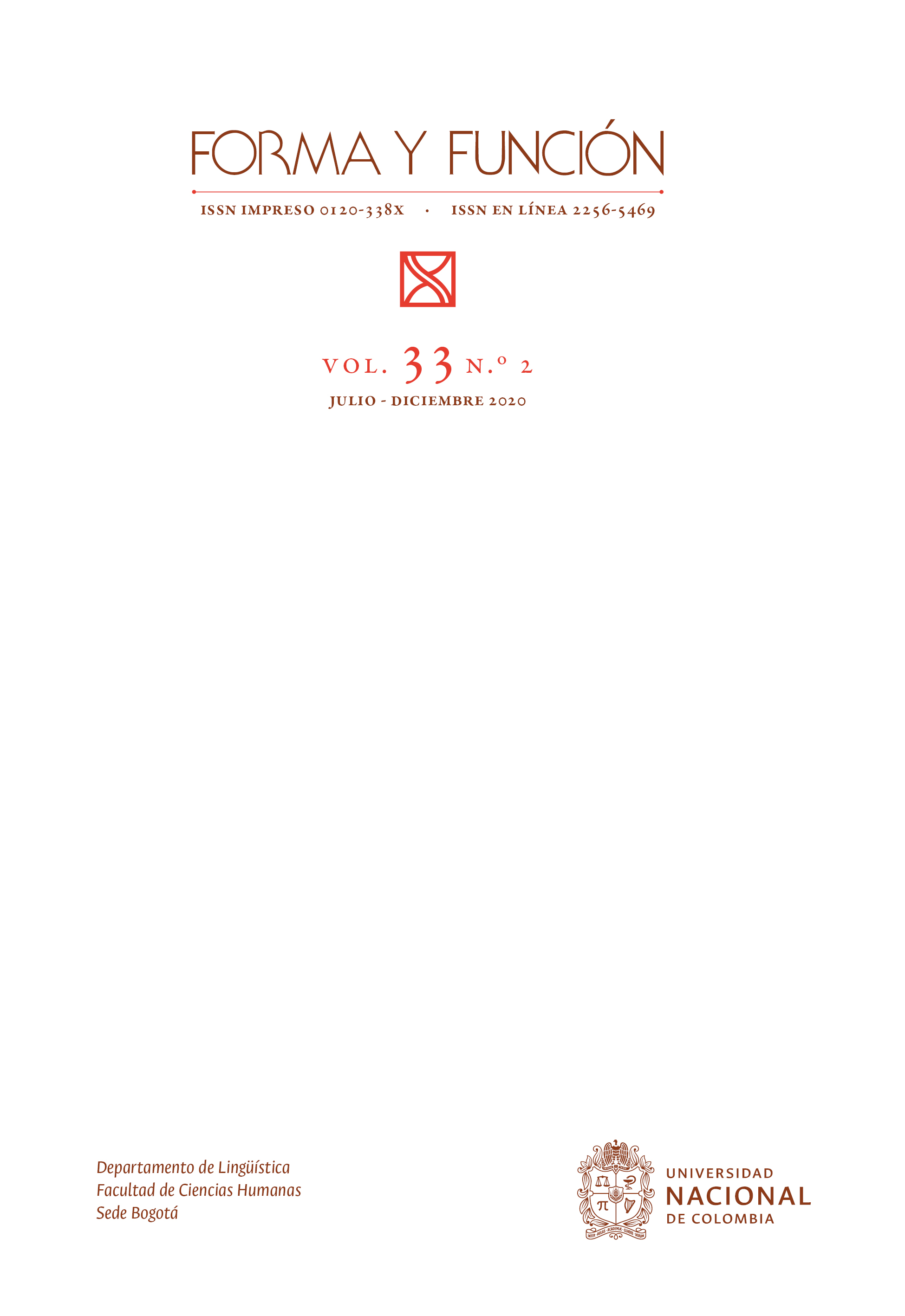¿Entrenamiento perceptivo o instrucción explícita? Percepción y producción de los patrones de voice onset time iniciales del inglés (le) por estudiantes brasileños
Perceptual Training or Explicit Instruction? Perception and Production of Initial Voice Onset Time Patterns in English (fl) by Brazilian students
Treinamento perceptual ou instrução explícita? Percepção e produção dos padrões de voice onset time iniciais do inglês (le) por estudantes brasileiros
DOI:
https://doi.org/10.15446/fyf.v33n2.81067Palabras clave:
entrenamiento, instrucción, percepción, producción, pronunciación (es)training, instruction, perception, production, pronunciation (en)
treinamento, instrução, percepção, produção, pronúncia (pt)
Descargas
En inglés, el voice onset time (vot) desempeña un rol crucial en las distinciones entre oclusivas sordas y sonoras en posición inicial de palabra. La combinación de las prácticas de entrenamiento perceptivo e instrucción explícita ofrece beneficios para la percepción y producción de esos segmentos por estudiantes de inglés. En este trabajo investigamos si la aplicación de cada una de esas técnicas brinda resultados positivos en términos de percepción y de producción de las oclusivas sordas aspiradas /p/, /t/ y /k/. Para ello, participaron 30 estudiantes brasileños de inglés, divididos en tres grupos, cada uno expuesto a diferentes tratamientos. Los participantes realizaron tareas de identificación y producción oral en tres momentos distintos (pretest, postest y postest tardío). Los resultados muestran que el entrenamiento perceptivo promueve mejoras en la percepción, pero no así en la producción. Por su parte, la instrucción explícita con prácticas de producción genera avances en la producción únicamente.
In English, Voice Onset Time (vot) plays a crucial role in the differentiation between voiceless and voiced stop sounds in word-initial position. The combination of practices of perceptual training and explicit instruction enhance the perception and production of these segments by students of English. We investigate whether the application of each of these techniques produces positive results in terms of the perception and production of aspirated voiceless stops /p/, /t/ and /k/. Thirty Brazilian students divided into three groups participated in the study, with each group exposed to different treatments. Participants carried out identification and oral production tasks in three different moments (pretest, posttest, and delayed posttest). The results show that perceptual training improves perception, but not production. On the other hand, explicit instruction with production practices only improve production.
In English, Voice Onset Time (vot) plays a crucial role in the differentiation between voiceless and voiced stop sounds in word-initial position. The combination of practices of perceptive training and explicit instruction enhance the perception and production of these segments by students of English. We investigate whether the application of each of these techniques produces positive results in terms of the perception and production of aspirated voiceless stops /p/, /t/ and /k/. Thirty Brazilian students divided into three groups participated in the study, with each group exposed to different treatments. Participants carried out identification and oral production tasks in three different moments (pretest, posttest, and delayed posttest). The results show that perceptual training improves perception, but not production. On the other hand, explicit instruction with production practices only improve production.Em inglês, o voice onset time (vot) desempenha um papel crucial nas distinções entre oclusivas surdas e sonoras em posição inicial de palavra. A combinação de práticas de treinamento perceptual e instrução explícita oferece benefícios para a percepção e produção desses segmentos por parte de estudantes de inglês. Neste trabalho, pesquisamos se a aplicação de cada uma dessas técnicas oferece resultados positivos em termos de percepção e produção das oclusivas surdas aspiradas /p/, /t/ e /k/. Para isso, participaram trinta estudantes brasileiros, divididos em três grupos, cada um exposto a diferentes tratamentos. Os participantes realizaram tarefas de identificação e produção oral em três momentos distintos (pré-teste, pós-teste e pós-teste tardio). Os resultados mostram que o treinamento perceptual promove melhorias na percepção, mas não na produção. Por sua vez, a instrução explícita com práticas de produção gera avanços unicamente na produção.
Referencias
Abramson, A. S., & Lisker, L. (1973). Voice-timing perception in Spanish word-initial stops. Journal of Phonetics, 1(1), 1-8. doi: https://doi.org/10.1016/S0095-4470(19)31372-5
Aliaga-García, C. (2011). Measuring perceptual cue weighting after training: a comparison of auditory vs. articulatory training methods. En M. Wrembel, M. Kul, & K. Dziubalska-Kolaczyk (Eds.), Achievements and Perspectives in sla of Speech: New Sounds 2010 (pp. 12-18). Frankfurt am Main: Peter Lang.
Alves, U. K., & Luchini, P. L. (2016). Percepción de la distinción entre oclusivas sordas y sonoras iniciales del inglés (le) por estudiantes argentinos: datos de identificación y discriminación. Revista Lingüística (alfal), 32, 25-39. doi: https://doi.org/10.5935/2079-312X.20160002
Alves, U. K., & Luchini, P. L. (2017). Effects of perceptual training on the identification and production of word-initial voiceless stops by Argentinean learners of English. Ilha do Desterro, 70(3), 15-32. doi: https://doi.org/10.5007/2175-8026.2017v70n3p15
Alves, U. K., & Magro, V. (2011). Raising awareness of l2 phonology: explicit instruction and the acquisition of aspirated /p/ by Brazilian Portuguese speakers. Letras de Hoje, 46(3), 71-80.
Alves, U. K., & Motta, C. S. (2014). Focusing on the right cue: perception of voiceless and voiced stops in English by Brazilian learners. Phrasis, 50, 31-50.
Alves, U. K., & Zimmer, M. C. (2015). Percepção e produção dos padrões de vot do inglês por aprendizes brasileiros: o papel de múltiplas pistas acústicas sob uma perspectiva dinâmica. Alfa Revista de Linguística, 59(1), 157-180. doi: https://doi.org/10.1590/1981-5794-1502-7
Boersma, P., & Weenink, D. (2017). Praat (versión 5.4.21). Recuperado de http://www.praat.org
Carlet, A. (2017). l2 perception and production of English consonants and vowels by Catalan speakers: the effects of attention and training task in a cross-training study (tesis de doctorado). Universidad Autónoma de Barcelona, España.
Carlet, A., & Cebrian, J. (2015). Identification vs. discrimination training: learning effects for trained and untrained sounds. En The Scottish Consortium for ICPhS 2015 (Ed.). Proceedings of the 18th International Congress of Phonetic Sciences. The University of Glasgow, United Kingdom. Recuperado de https://www.internationalphoneticassociation.org/icphs-proceedings/ICPhS2015/Papers/ICPHS0752.pdf
Carlet, A., & Cebrian, J. (2019). Assessing the effect of perceptual training on l2 vowel identification, generalization and long-term effects. En A. M. Nyvad, M. Hejná, A. Hojen, A. B. Jespersen, & M. H. Sorensen (Eds.), A sound approach to language matters (pp. 91-119). Aarhus: Aarhus University.
Cebrian, J., Carlet, A., Gorba, A., & Gavaldà, N. (2019). Perceptual training affects l2 perception but not cross-linguistic similarity. En S. Calhoun, P. Escudero, M. Tabain, & P. Warren (Eds.), Proceedings of the 19th International Congress of Phonetic Sciences (pp. 929-933). Canberra: Australasian Speech Science and Technology Association Inc.
Celce-Murcia, M., Briton, D. M., Goodwin, J. M, & Griner, B. (2010). Teaching Pronunciation (2a. ed.). Cambridge: Cambridge University Press.
Cho, T., & Ladefoged, P. (1999). Variation and universals in vot: evidence from 18 languages. Journal of Phonetics, 27(2), 207-229. doi: https://doi.org/10.1006/jpho.1999.0094
DeKeyser, R. (2015). Skill Acquisition Theory. En B. Van Patten, & J. Williams (Eds.), Theories in Second Language Acquisition (2a. ed.) (pp. 94-112). New York: Routledge.
Echelberger, A. D. (2013). Explicit pronunciation instruction and its impact on the intelligibility of literacy level adult el learners (tesis de maestría). Hamline University, Estados Unidos.
Flege, J. E. (1989). Chinese subjects’ perception of the word-final English /t/-/d/ contrast: performance before and after training. Journal of the Acoustical Society of America, 89(1), 1684-1697. doi: https://doi.org/10.1121/1.398599
Gordon, J., & Darcy, I. (2016). The development of comprehensible speech in l2 learners: a classroom study on the effects of short-term pronunciation instruction. Journal of Second Language Pronunciation, 2(1), 56-92. doi: https://doi.org/10.1075/jslp.2.1.03gor
Holt, L., & Lotto, A. (2006). Cue weighting in auditory categorization: implications for first and second language acquisition. The Journal of the Acoustical Society of America, 119(5), 3059-3071. doi: https://doi.org/10.1121/1.2188377
Iverson, P., & Evans, B. G. (2009). Learning English vowels with different first language vowel systems ii: auditory training for native Spanish and German speakers. The Journal of the Acoustical Society of America, 126(2), 866-877. doi: https://doi.org/10.1121/1.3148196
Iverson, P., Pinet, M., & Evans, B. G. (2012). Auditory training for experienced and inexperienced second language learners: native French speakers learning English vowels. Applied Psycholinguistics, 33(1), 145-160. doi: https://doi.org/10.1017/S0142716411000300
Jamieson, D., & Morosan, D. (1986). Training non-native speech contrasts in adults: acquisition of the English contrast by francophones. Perception and Psychophysics, 40(4), 205-215. doi: https://doi.org/10.3758/BF03211500
Jamieson, D., & Morosan, D. (1989). Training new, nonnative speech contrasts: A comparison of the prototype and perceptual fading techniques. Canadian Journal of Psychology, 43, 88-96. doi: https://doi.org/10.1037/h0084209
Kissling, E. (2013). Teaching pronunciation: is explicit phonetics instruction beneficial for FL Learners? Modern Language Journal, 97(3), 720-744. doi: https://doi.org/10.1111/j.1540-4781.2013.12029.x
Kong, E. J., Beckman, M. E., & Edwards, J. (2012). Voice Onset Time is necessary but not always sufficient to describe acquisition of voiced stops: the cases of Greek and Japanese. Journal of Phonetics, 40(6), 725-744. doi: https://doi.org/10.1016/j.wocn.2012.07.002
Kupske, F. F. (2016). Imigração, Atrito e Complexidade: A produção das oclusivas surdas iniciais do Inglês e do Português por Sul-Brasileiros residentes em Londres (tesis de doctorado). Universidade Federal do Rio Grande do Sul, Brasil.
Larson-Hall, J. (2009). A guide to doing statistics in Second Language Research using spss. New York: Routledge. doi: https://doi.org/10.4324/9780203875964
Lisker, L., & Abramson, A. S. (1964). A cross-language study of voicing in initial stops: acoustical measurements. Word, 20(3), 384-422. doi: https://doi.org/10.1080/00437956.1964.11659830
Logan, J. S., & Pruitt, J. S. (1995). Methodological issues in training listeners to perceive non-native phonemes. En W. Strange (Ed.), Speech perception and linguistic experience: issues in cross-language research (pp. 351-378). Baltimore: York Press.
Nobre-Oliveira, D. (2007). The effect of perceptual training on the learning of English vowels by Brazilian Portuguese speakers (tesis de doctorado). Universidade Federal de Santa Catarina, Brasil.
Nozawa, T. (2015). Effects of attention and training method on the identification of American English coda nasals by native Japanese listeners. En The Scottish Consortium for ICPhS 2015 (Ed.), Proceedings of the 18th International Congress of Phonetic Sciences. Glasgow: The University of Glasgow. doi: https://doi.org/10.1121/1.4934161
Pollitt, A. (2007). The meaning of oopt Scores. Recuperado de https://www.oxfordenglishtesting.com
Purpura, J. (2007). The Oxford Placement Test: what does it measure and how? Recuperado de https://www.oxfordenglishtesting.com
Rato, A. (2013). Cross-language perception and production of English vowels by Portuguese learners: the effects of perceptual training (tesis de doctorado). Universidade do Minho, Brasil.
Rauber, A. S., Rato, A., Santos, G. R., Kluge, D. C., & Figueiredo, M. (2013). tp: Testes de Percepção e Treinamento Perceptual com Feedback Imediato (versión 3.1). Recuperado de http://www.worken.com.br/tp_regfree.php. 2013
Reis, M., & Nobre-Oliveira, D. (2008). Effects of perceptual training on the identification and production of the English voiceless plosives aspiration by Brazilian efl learners. En A. S. Rauber, M. A. Watkins, & B. O. Baptista (Eds.), New Sounds 2007: Proceedings of the Fifth International Symposium on the Acquisition of Second Language Speech (pp. 398-407). Florianópolis: Editora da Universidade Federal de Santa Catarina.
Saito, K., & Hanzawa, K. (2016). Developing second language oral ability in foreign language classrooms: the role of the length and focus of instruction and individual differences. Applied Psycholinguistics, 37(4), 813-840. doi: https://doi.org/10.1017/S0142716415000259
Saito, K., & Plonsky, L. (2019). Effects of second language pronunciation teaching revisited: a proposed measurement framework and meta-analysis. Language Learning, 69(3), 652-708. doi: https://doi.org/10.1111/lang.12345
Saito, Y., & Saito, K. (2017). Differential effects of instruction on the development of second language comprehensibility, word stress, rhythm, and intonation: the case of inexperienced Japanese efl learners. Language Teaching Research, 21(5), 589-608. doi: https://doi.org/10.1177/1362168816643111
Sakai, M., & Moorman, C. (2018). Can perceptual training improve the production of second language phonemes? A meta-analytic review of 25 years of perceptual training research. Applied Psycholinguistics, 39(1), 187-224. doi: https://doi.org/10.1017/S0142716417000418
Sangüesa, V. M. (2016). The second time around: the effect of FI upon return from SA (tesis de maestría). Universitat Pompeu Fabra, España.
Schwartzhaupt, B. M. (2012). Factors Influencing Voice Onset Time: analyzing Brazilian Portuguese, English and Interlanguage data (trabajo de grado). Universidade Federal do Rio Grande do Sul, Brasil.
Schwarzhaupt, B. M., Alves, U. K., & Fontes, A. B. A. L. (2015). The role of l1 knowledge on l2 speech perception: investigating how native speakers and Brazilian learners categorize different vot patterns in English. Revista de Estudos da Linguagem, 23(2), 311-334. doi: https://doi.org/10.17851/2237-2083.23.2.311-334
Sicola, L., & Darcy, I. (2015). Integrating pronunciation into the language classroom. En M. Reed, & J. M. Levis (Eds.), The handbook of English pronunciation (pp. 546-566). Oxford: Blackwell. doi: https://doi.org/10.1002/9781118346952.ch26
Simon, E., & Leuschner, T. (2010). Laryngeal systems in Dutch, English and German: a constrastive-phonological study on second and third language acquisition. Journal of Germanic Linguistics, 22(4), 403-424. doi: https://doi.org/10.1017/S1470542710000127
Sundara, M. (2005). Acoustic phonetics of coronal stops: a cross-language study of Canadian English and Canadian French. Journal of the Acoustical Society of America, 118, 1026-1037. doi: https://doi.org/10.1121/1.1953270
Thomson, R. I., & Derwing, T. M. (2015). The effectiveness of l2 pronunciation instruction: a narrative review. Applied Linguistics, 36(3), 326-344. doi: https://doi.org/10.1093/applin/amu076
Wang, X., & Munro, M. (2004). Computer-based training for learning English vowel contrasts. System, 32(4), 539-552. doi: https://doi.org/10.1016/j.system.2004.09.011
Wong, J. (2012). Training the perception and production of English /e/ and /æ/ of Cantonese esl learners: a comparison of low vs. high variability phonetic training. Proceedings of the 14th Australasian International Conference on Speech Science and Technology (pp. 3-6). Sydney: Australian Speech Science and Technology Association.
Yavas, M., & Wildermuth, R. (2006). The effects of place of articulation and vowel height in the acquisition of English aspirated stops by Spanish speakers. iral, 44(3), 251-263. doi: https://doi.org/10.1515/IRAL.2006.011
Zimmer, M. C., Silveira, R., & Alves, U. K. (2009). Pronunciation Instruction for Brazilians: Bringing Theory and Practice Together. Newcastle: Cambridge Scholars Publishing.
Cómo citar
APA
ACM
ACS
ABNT
Chicago
Harvard
IEEE
MLA
Turabian
Vancouver
Descargar cita
CrossRef Cited-by
1. Ubiratã Kickhöfel Alves, Felipe Guedes Moreira Vieira. (2022). O treinamento perceptual no desenvolvimento dos padrões de Voice Onset Time do inglês (L2) por um aprendiz argentino. BELT - Brazilian English Language Teaching Journal, 13(1), p.e42967. https://doi.org/10.15448/2178-3640.2022.1.42967.
Dimensions
PlumX
Visitas a la página del resumen del artículo
Descargas
Licencia
Derechos de autor 2020 Forma y Función

Esta obra está bajo una licencia internacional Creative Commons Atribución-NoComercial-CompartirIgual 4.0.
Forma y Función está suscrita al convenio Open Journal System, lo que significa que tiene el carácter de acceso abierto. Se provee acceso libre e inmediato a su contenido, bajo el principio de que hacer disponible gratuitamente los resultados de investigación contribuye a la divulgación global del conocimiento, así como al intercambio académico que propicia vínculos entre las comunidades científicas. Los usuarios pueden buscar, leer, copiar, descargar y compartir la totalidad de los textos publicados. Se autoriza su uso, siempre y cuando se conceda el crédito a los autores de los textos y a Forma y Función como fuente original de la publicación. No se permite el uso comercial de copia o distribución de contenidos, así como tampoco la adaptación, derivación o transformación alguna de estos sin la autorización previa de los autores y del editor de Forma y Función.
Los contenidos de la revista son publicados en acceso abierto bajo la Licencia Creative Commons Atribución-NoComercial-CompartirIgual 4.0 Internacional. Para mayor información sobre los términos de la licencia, se puede consultar: http://creativecommons.org/licenses/by-nc-sa/4.0/legalcode.
En consonancia con la política de acceso abierto, Forma y Función no aplica cargos por el procesamiento de los textos enviados, ni por su publicación.



























